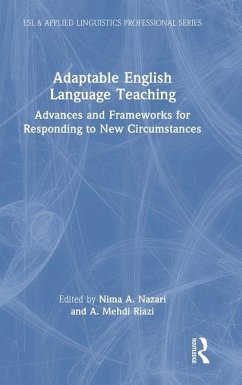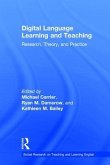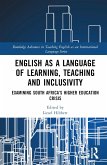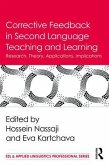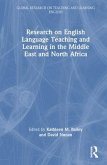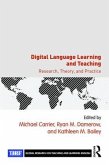Adaptable English Language Teaching
Advances and Frameworks for Responding to New Circumstances
Herausgeber: Nazari, Nima A.; Riazi, A. Mehdi
Adaptable English Language Teaching
Advances and Frameworks for Responding to New Circumstances
Herausgeber: Nazari, Nima A.; Riazi, A. Mehdi
- Gebundenes Buch
- Merkliste
- Auf die Merkliste
- Bewerten Bewerten
- Teilen
- Produkt teilen
- Produkterinnerung
- Produkterinnerung
The ELT community must adapt to the needs of emerging situations and a diverse range of learners. Adaptable English Language Teaching brings together contributions from renowned scholars around the world with insights on all major areas of English language teaching with an emphasis on adaptability.
Andere Kunden interessierten sich auch für
![Considering Emotions in Critical English Language Teaching Considering Emotions in Critical English Language Teaching]() Sarah BeneschConsidering Emotions in Critical English Language Teaching66,99 €
Sarah BeneschConsidering Emotions in Critical English Language Teaching66,99 €![Digital Language Learning and Teaching Digital Language Learning and Teaching]() Digital Language Learning and Teaching192,99 €
Digital Language Learning and Teaching192,99 €![English as a Language of Learning, Teaching and Inclusivity English as a Language of Learning, Teaching and Inclusivity]() English as a Language of Learning, Teaching and Inclusivity181,99 €
English as a Language of Learning, Teaching and Inclusivity181,99 €![Corrective Feedback in Second Language Teaching and Learning Corrective Feedback in Second Language Teaching and Learning]() Corrective Feedback in Second Language Teaching and Learning54,99 €
Corrective Feedback in Second Language Teaching and Learning54,99 €![Research on English Language Teaching and Learning in the Middle East and North Africa Research on English Language Teaching and Learning in the Middle East and North Africa]() Research on English Language Teaching and Learning in the Middle East and North Africa182,99 €
Research on English Language Teaching and Learning in the Middle East and North Africa182,99 €![Emotions and English Language Teaching Emotions and English Language Teaching]() Sarah BeneschEmotions and English Language Teaching191,99 €
Sarah BeneschEmotions and English Language Teaching191,99 €![Digital Language Learning and Teaching Digital Language Learning and Teaching]() Digital Language Learning and Teaching64,99 €
Digital Language Learning and Teaching64,99 €-
-
-
The ELT community must adapt to the needs of emerging situations and a diverse range of learners. Adaptable English Language Teaching brings together contributions from renowned scholars around the world with insights on all major areas of English language teaching with an emphasis on adaptability.
Produktdetails
- Produktdetails
- Verlag: Routledge
- Seitenzahl: 294
- Erscheinungstermin: 6. September 2024
- Englisch
- Abmessung: 235mm x 157mm x 20mm
- Gewicht: 580g
- ISBN-13: 9781032422060
- ISBN-10: 1032422068
- Artikelnr.: 70147070
- Herstellerkennzeichnung
- Libri GmbH
- Europaallee 1
- 36244 Bad Hersfeld
- gpsr@libri.de
- Verlag: Routledge
- Seitenzahl: 294
- Erscheinungstermin: 6. September 2024
- Englisch
- Abmessung: 235mm x 157mm x 20mm
- Gewicht: 580g
- ISBN-13: 9781032422060
- ISBN-10: 1032422068
- Artikelnr.: 70147070
- Herstellerkennzeichnung
- Libri GmbH
- Europaallee 1
- 36244 Bad Hersfeld
- gpsr@libri.de
Nima A. Nazari is Professor of Applied Linguistics and works as Centre Director at OnCampus London South Bank University, UK. A. Mehdi Riazi is Professor of Applied Linguistics at the College of Humanities and Social Sciences of Hamad Bin Khalifa University (HBKU), Qatar.
Introduction
Section 1: ELT responses to new circumstances
Chapter 1: English language curriculum development in new circumstances
Chapter 2: Sustainability in English language teacher education: Preparing
teachers for an unknown future
Chapter 3: Understanding the needs of international EAP students: Adaptive
progress
Chapter 4: Silence as autonomy: Case studies of Australian and
international students
Section 2: ELT assessment, feedback, and managing classrooms in new
circumstances
Chapter 5: New approaches to the assessment of English as an additional
language
Chapter 6: Feedback to students in ELT
Chapter 7: ELT classroom management in times of change
Section 3: Teaching English language skills and components in new
circumstances
Chapter 8: Teaching listening in new circumstances
Chapter 9: Teaching reading
Chapter 10: Challenges and opportunities in teaching speaking
Chapter 11: L2 Writing Pedagogy: Responding to emerging needs and
emergencies
Chapter 12: Adaptable teaching of grammar, vocabulary, and pronunciation:
Enhancing fluency and engagement through online apps
Section 4: The contribution of technology to ELT in new circumstances
Chapter 13: Language teachers and teaching technologies: Valuing the
teacher and teacher values in online learning
Chapter 14: Computer-assisted language learning and teaching: Emerging
trends, challenges, and solutions in ELT
Chapter 15: A Multimodal analysis of roleplays between Upper Intermediate
level learners: lessons for teaching oral language competency in online
contexts
Conclusion
Section 1: ELT responses to new circumstances
Chapter 1: English language curriculum development in new circumstances
Chapter 2: Sustainability in English language teacher education: Preparing
teachers for an unknown future
Chapter 3: Understanding the needs of international EAP students: Adaptive
progress
Chapter 4: Silence as autonomy: Case studies of Australian and
international students
Section 2: ELT assessment, feedback, and managing classrooms in new
circumstances
Chapter 5: New approaches to the assessment of English as an additional
language
Chapter 6: Feedback to students in ELT
Chapter 7: ELT classroom management in times of change
Section 3: Teaching English language skills and components in new
circumstances
Chapter 8: Teaching listening in new circumstances
Chapter 9: Teaching reading
Chapter 10: Challenges and opportunities in teaching speaking
Chapter 11: L2 Writing Pedagogy: Responding to emerging needs and
emergencies
Chapter 12: Adaptable teaching of grammar, vocabulary, and pronunciation:
Enhancing fluency and engagement through online apps
Section 4: The contribution of technology to ELT in new circumstances
Chapter 13: Language teachers and teaching technologies: Valuing the
teacher and teacher values in online learning
Chapter 14: Computer-assisted language learning and teaching: Emerging
trends, challenges, and solutions in ELT
Chapter 15: A Multimodal analysis of roleplays between Upper Intermediate
level learners: lessons for teaching oral language competency in online
contexts
Conclusion
Introduction
Section 1: ELT responses to new circumstances
Chapter 1: English language curriculum development in new circumstances
Chapter 2: Sustainability in English language teacher education: Preparing
teachers for an unknown future
Chapter 3: Understanding the needs of international EAP students: Adaptive
progress
Chapter 4: Silence as autonomy: Case studies of Australian and
international students
Section 2: ELT assessment, feedback, and managing classrooms in new
circumstances
Chapter 5: New approaches to the assessment of English as an additional
language
Chapter 6: Feedback to students in ELT
Chapter 7: ELT classroom management in times of change
Section 3: Teaching English language skills and components in new
circumstances
Chapter 8: Teaching listening in new circumstances
Chapter 9: Teaching reading
Chapter 10: Challenges and opportunities in teaching speaking
Chapter 11: L2 Writing Pedagogy: Responding to emerging needs and
emergencies
Chapter 12: Adaptable teaching of grammar, vocabulary, and pronunciation:
Enhancing fluency and engagement through online apps
Section 4: The contribution of technology to ELT in new circumstances
Chapter 13: Language teachers and teaching technologies: Valuing the
teacher and teacher values in online learning
Chapter 14: Computer-assisted language learning and teaching: Emerging
trends, challenges, and solutions in ELT
Chapter 15: A Multimodal analysis of roleplays between Upper Intermediate
level learners: lessons for teaching oral language competency in online
contexts
Conclusion
Section 1: ELT responses to new circumstances
Chapter 1: English language curriculum development in new circumstances
Chapter 2: Sustainability in English language teacher education: Preparing
teachers for an unknown future
Chapter 3: Understanding the needs of international EAP students: Adaptive
progress
Chapter 4: Silence as autonomy: Case studies of Australian and
international students
Section 2: ELT assessment, feedback, and managing classrooms in new
circumstances
Chapter 5: New approaches to the assessment of English as an additional
language
Chapter 6: Feedback to students in ELT
Chapter 7: ELT classroom management in times of change
Section 3: Teaching English language skills and components in new
circumstances
Chapter 8: Teaching listening in new circumstances
Chapter 9: Teaching reading
Chapter 10: Challenges and opportunities in teaching speaking
Chapter 11: L2 Writing Pedagogy: Responding to emerging needs and
emergencies
Chapter 12: Adaptable teaching of grammar, vocabulary, and pronunciation:
Enhancing fluency and engagement through online apps
Section 4: The contribution of technology to ELT in new circumstances
Chapter 13: Language teachers and teaching technologies: Valuing the
teacher and teacher values in online learning
Chapter 14: Computer-assisted language learning and teaching: Emerging
trends, challenges, and solutions in ELT
Chapter 15: A Multimodal analysis of roleplays between Upper Intermediate
level learners: lessons for teaching oral language competency in online
contexts
Conclusion

